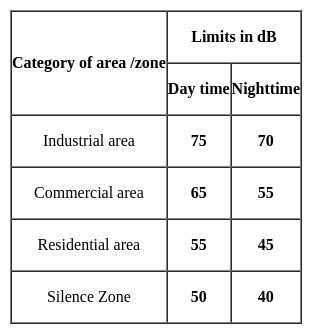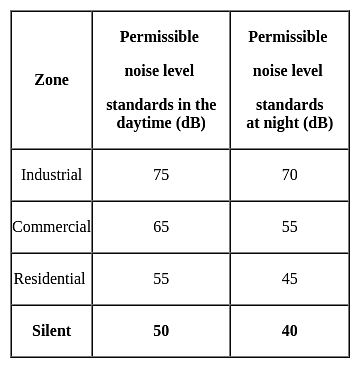Software Development Exam > Software Development Tests > Test: Environmental Awareness (Noise Pollution) - Software Development MCQ
Test: Environmental Awareness (Noise Pollution) - Software Development MCQ
Test Description
20 Questions MCQ Test - Test: Environmental Awareness (Noise Pollution)
Test: Environmental Awareness (Noise Pollution) for Software Development 2025 is part of Software Development preparation. The Test: Environmental Awareness (Noise Pollution) questions and answers have been prepared
according to the Software Development exam syllabus.The Test: Environmental Awareness (Noise Pollution) MCQs are made for Software Development 2025 Exam.
Find important definitions, questions, notes, meanings, examples, exercises, MCQs and online tests for Test: Environmental Awareness (Noise Pollution) below.
Solutions of Test: Environmental Awareness (Noise Pollution) questions in English are available as part of our course for Software Development & Test: Environmental Awareness (Noise Pollution) solutions in
Hindi for Software Development course.
Download more important topics, notes, lectures and mock test series for Software Development Exam by signing up for free. Attempt Test: Environmental Awareness (Noise Pollution) | 20 questions in 20 minutes | Mock test for Software Development preparation | Free important questions MCQ to study for Software Development Exam | Download free PDF with solutions
Detailed Solution for Test: Environmental Awareness (Noise Pollution) - Question 1
Detailed Solution for Test: Environmental Awareness (Noise Pollution) - Question 2
Test: Environmental Awareness (Noise Pollution) - Question 3
Which of the following do not contribute to a noise pollution?
Detailed Solution for Test: Environmental Awareness (Noise Pollution) - Question 3
Test: Environmental Awareness (Noise Pollution) - Question 4
When was Noise Pollution (Regulation and Control) Rules enacted?
Detailed Solution for Test: Environmental Awareness (Noise Pollution) - Question 4
Test: Environmental Awareness (Noise Pollution) - Question 5
Noise pollution is considered to be caused by sounds louder than
Detailed Solution for Test: Environmental Awareness (Noise Pollution) - Question 5
Test: Environmental Awareness (Noise Pollution) - Question 6
Which of the following steps can be taken to control noise pollution?
Detailed Solution for Test: Environmental Awareness (Noise Pollution) - Question 6
Detailed Solution for Test: Environmental Awareness (Noise Pollution) - Question 7
Test: Environmental Awareness (Noise Pollution) - Question 8
The noise level of 10 dB is how many times more powerful than the noise level of 1 dB
Detailed Solution for Test: Environmental Awareness (Noise Pollution) - Question 8
Test: Environmental Awareness (Noise Pollution) - Question 9
The noise pollution produced by tractors, thrashers harvesters etc. can be categorized under
Detailed Solution for Test: Environmental Awareness (Noise Pollution) - Question 9
Test: Environmental Awareness (Noise Pollution) - Question 10
The noise pollution which produces pain in the heart and narrowing of arteries comes under following effect:-
Detailed Solution for Test: Environmental Awareness (Noise Pollution) - Question 10
Test: Environmental Awareness (Noise Pollution) - Question 11
As per Central Pollution Control Board (CPCB) India, the permitted values of noise level in a silence zone during the day time and night time are respectively:
Detailed Solution for Test: Environmental Awareness (Noise Pollution) - Question 11
Test: Environmental Awareness (Noise Pollution) - Question 12
How to prevent noise pollution in and around a school?
Detailed Solution for Test: Environmental Awareness (Noise Pollution) - Question 12
Test: Environmental Awareness (Noise Pollution) - Question 13
Which institution has laid down permissible noise limits in India?
Detailed Solution for Test: Environmental Awareness (Noise Pollution) - Question 13
Test: Environmental Awareness (Noise Pollution) - Question 14
Which act of Government of India includes noise as environmental pollution ?
Detailed Solution for Test: Environmental Awareness (Noise Pollution) - Question 14
Test: Environmental Awareness (Noise Pollution) - Question 15
Which of the following is the loudest sound of noise?
Detailed Solution for Test: Environmental Awareness (Noise Pollution) - Question 15
Test: Environmental Awareness (Noise Pollution) - Question 16
The device used to reduce exhaust noise is called
Detailed Solution for Test: Environmental Awareness (Noise Pollution) - Question 16
Test: Environmental Awareness (Noise Pollution) - Question 17
Which of the following is not a source of noise pollution?
Detailed Solution for Test: Environmental Awareness (Noise Pollution) - Question 17
Test: Environmental Awareness (Noise Pollution) - Question 18
The faintest detectable noise by a healthy human ear is of :
Detailed Solution for Test: Environmental Awareness (Noise Pollution) - Question 18
Test: Environmental Awareness (Noise Pollution) - Question 19
Which of the following is not an example of noise?
Detailed Solution for Test: Environmental Awareness (Noise Pollution) - Question 19
Test: Environmental Awareness (Noise Pollution) - Question 20
Noise levels are measured in decibels. What is the decibel of normal talk?
Detailed Solution for Test: Environmental Awareness (Noise Pollution) - Question 20
Information about Test: Environmental Awareness (Noise Pollution) Page
In this test you can find the Exam questions for Test: Environmental Awareness (Noise Pollution) solved & explained in the simplest way possible.
Besides giving Questions and answers for Test: Environmental Awareness (Noise Pollution), EduRev gives you an ample number of Online tests for practice
Download as PDF




















